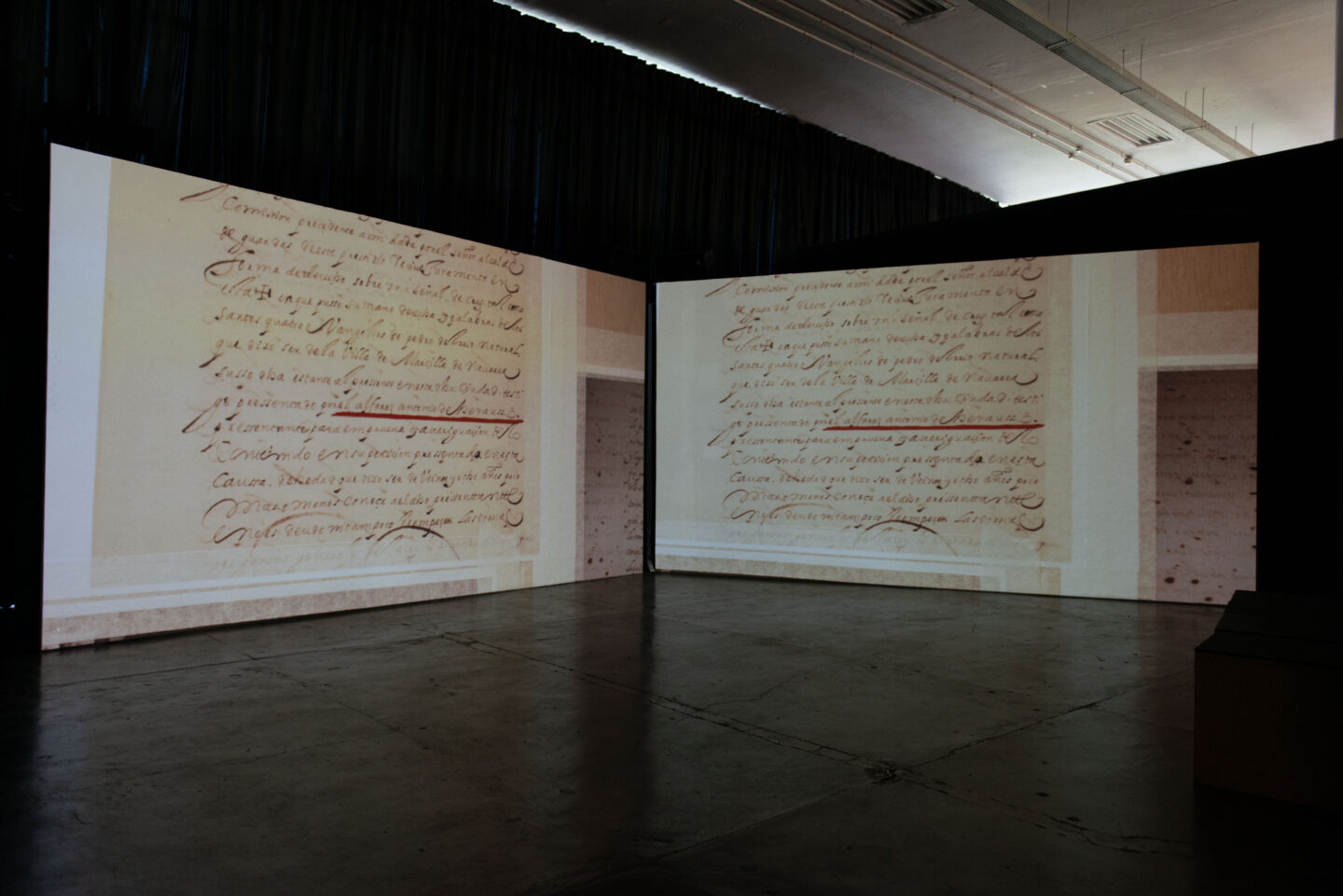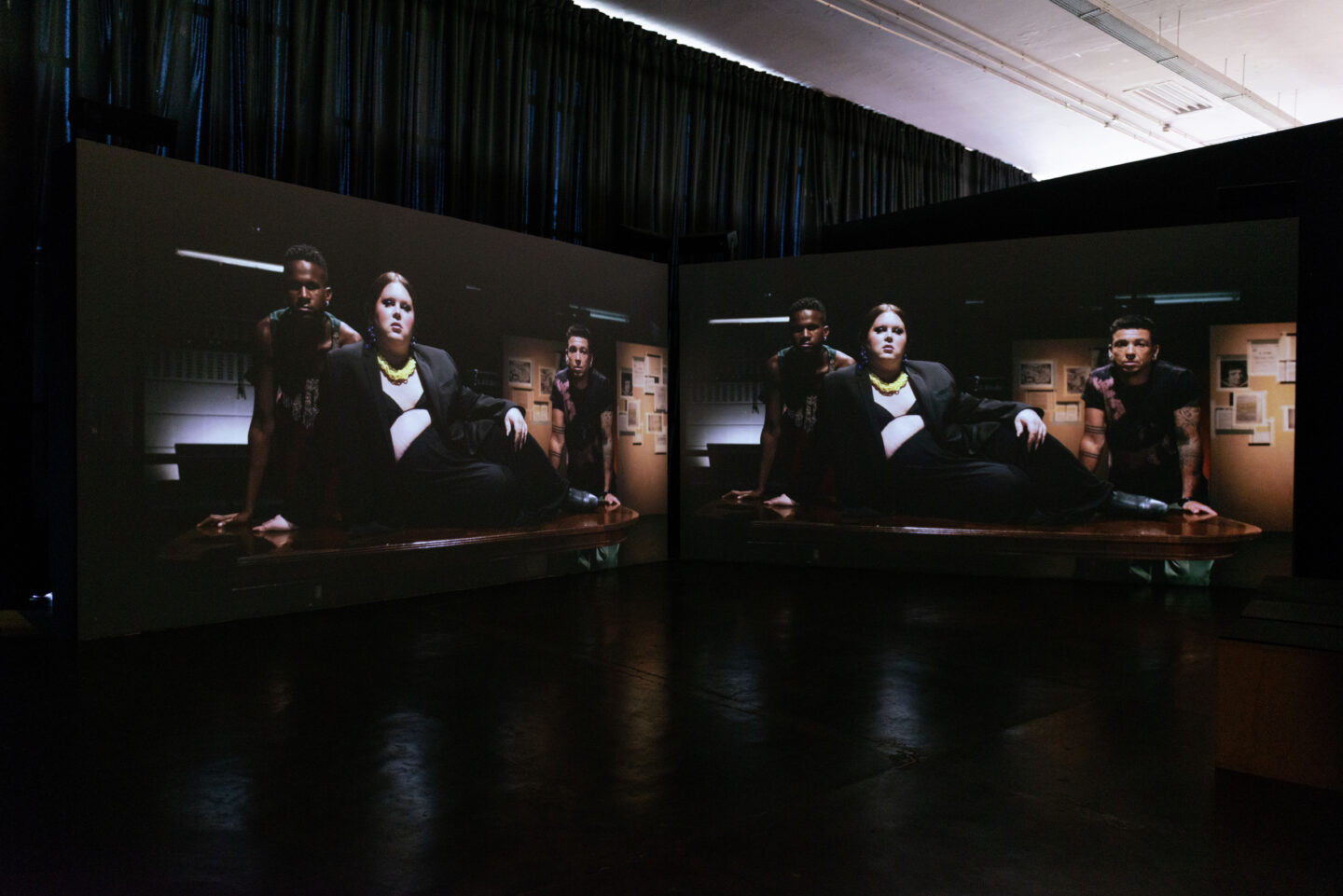
Cabello/Carceller
Since their emergence on the contemporary art scene in the mid- 1990s, the work of Helena Cabello and Ana Carceller has questioned the devices and conventions of the representation of sexualities and identities outside the norm.
In Una voz para Erauso. Un epílogo para un tiempo trans [A Voice for Erauso. An Epilogue for a Trans Time] (2021–23), the artists bring the complex biography of Antonio de Erauso to the present. Known as “The Nun Ensign,” he was a character from the Spanish colonial baroque famous for having managed to circumvent the gender binarism imposed on the bodies of the Empire.
The work develops in a game of distancing that weaves a queer and almost hauntological ¹ temporality. Four centuries later, three non-bi- nary trans people question the portrait of the ensign and, through it, unfold a fundamental issue: the right to be named. However, far from creating a new queer hagiography, the protagonists build up the narrative and expose its dark areas: Erauso’s confessed racism, his participation in the Mapuche genocide, the high levels of violence that permeate his history.
Thus, Cabello/Carceller expose a series of strategies that delve into several key aspects. The first is that every portrait is always performative. The second, as Paul B. Preciado explains, is that the figure of Erauso is a discursive and visual territory in dispute, a place “where a multiplicity of conflicting identities is constructed and deconstructed”².
In a historically dense queer gesture, Cabello/Carceller outlines dissident counter-images on the margins. Whether at a glance or through connotations, these footnotes reveal elusive, discontinuous, and bastard genealogies. As another addition to van der Hamen’s oil painting, as an Una voz para Erauso. Un epílogo para un tiempo trans, Cabello/Carceller’s words and scenes challenge the integrity of the hegemonic and make art a tool to address the ever-flickering horizon of subjectivities that lie ahead.
beatriz martínez hijazo
translated from Spanish by ana laura borro
1. In French hantologie, a concept created by Jacques Derrida in his book Espectres de Marx (1993), in which he unites the terms hanter [to haunt] and ontologie [ontology], referring to the persistent return to theories of the past. [e.n.]
2. Paul B. Preciado, “Una voz para Erauso. Epílogo para un tiempo trans”, in Cabello/ Carceller. Una voz para Erauso. Epílogo para un tiempo trans. Exhibition catalog. Bilbao: Azkuna Zentroa – Alhóndiga Bilbao, 2022, p. 14. [e.n.]
- Vista da obra Una voz para Erauso. Epílogo para un tiempo trans [Uma voz para Erauso. Epílogo para um tempo trans], de Cabello/Carceller durante a 35ª Bienal de São Paulo – coreografias do impossível © Levi Fanan / Fundação Bienal de São Paulo
- Vista da obra Una voz para Erauso. Epílogo para un tiempo trans [Uma voz para Erauso. Epílogo para um tempo trans], de Cabello/Carceller durante a 35ª Bienal de São Paulo – coreografias do impossível © Levi Fanan / Fundação Bienal de São Paulo
- Vista da obra Una voz para Erauso. Epílogo para un tiempo trans [Uma voz para Erauso. Epílogo para um tempo trans], de Cabello/Carceller durante a 35ª Bienal de São Paulo – coreografias do impossível © Levi Fanan / Fundação Bienal de São Paulo
- Vista da obra Una voz para Erauso. Epílogo para un tiempo trans [Uma voz para Erauso. Epílogo para um tempo trans], de Cabello/Carceller durante a 35ª Bienal de São Paulo – coreografias do impossível © Levi Fanan / Fundação Bienal de São Paulo
- Vista da obra Una voz para Erauso. Epílogo para un tiempo trans [Uma voz para Erauso. Epílogo para um tempo trans], de Cabello/Carceller durante a 35ª Bienal de São Paulo – coreografias do impossível © Levi Fanan / Fundação Bienal de São Paulo
Cabello/Carceller (Paris, France, 1963. Madrid, Spain, 1964. Live in Madrid, Spain) is an artist team founded in 1992 who are also university professors. Through interdisciplinary work spanning media-installation, performance, video, writing, and drawing, they challenge hegemonic modes of representation and offer critical alternatives. Their work has been featured in several solo, collective, and group exhibitions at institutions such as the Spanish Pavillion at 56th Venice Biennale (Italy), Brooklyn Museum (New York, USA), Moscow Museum of Modern Art (Moscow, Russia), Museo Universitario Arte Contemporáneo (Mexico City, Mexico), Museu de Arte Contemporánea de Vigo (Pontevedra, Spain) and El Centro de Arte Dos de Mayo (Madrid, Spain), among others. They also curated shows at Espacio Off Limits (Madrid, Spain), Espacio de Arte Contemporáneo de Castellón (Spain), and Universidad Europea de Madrid (Spain).

 Português
Português



